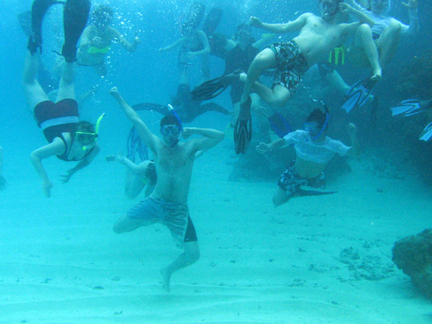Bahamas or Bust!
Our regional field geology class headed south this winter, spending spring break on San Salvador Island in the Bahamas studying modern marine carbonate environments and their sediments! My co-instructor, John Milliman (School of Marine Science, VIMS) and I had the incredible opportunity to travel to the subtropics with 18 undergraduates, with financial support from geology alumni, the geology department, and the Charles Center. San Salvador, the supposed landing site of Christopher Columbus, is the perfect destination to study modern carbonates. Although the island is only 12 miles long, it boasts a diversity of modern and fossil depositional environments, all easily accessible from the Gerace Research Center, which was our home-base on the north end of the island.
We spent the first day of the trip exploring the patch reefs just down the road from the research center, and giving students the opportunity to get comfortable with their snorkeling gear. We then hiked along North Point with its spectacular lithified carbonate sand dunes, which represent the youngest rocks on the island (less than 500 years old). The next day, we spelunked our way through a tidal flank margin cave, noting a myriad of features including stalactites and stalagmites, along with plentiful cave bacon and cave ooids. One bat but no snakes, much to Rob Poirier’s relief. That afternoon, we traveled back in time to what could have passed for a Precambrian experience, wading into and coring hypersaline Storr’s Lake, one of the rare places on Earth where you can get up close and personal with modern stromatolites.
We spent the next few days comparing modern and fossil patch reefs, alternating between swimming over shallow reef topography and then hiking over the same species in the exposed Pleistocene reefs. We were disappointed to see how the combination of disease, recent hurricanes, overfishing and climate change have contributed to coral die-off in the modern reefs. But we still marveled at seeing major reef-building coral taxa, such as Acropora cervicornis, A. palmata, and Montastrea annularis in both living and fossil forms. Students also got their fill of starfish, seaurchins, spiny lobsters, brightly colored sponges and sea fans, conchs, porcupinefish, the occasional Mola (sunfish), barracuda, and the recent invader from Asia—the venomous lionfish. We were able to collect sediments and beachrocks from a variety of sites with different beach morphologies and wave and current exposures, giving students the opportunity to appreciate, among other things, ooid, grapestone, and pellet formation. Pigeon Creek, which is a tidal creek on the southeastern side of the island, was a particularly popular snorkel—with habitats ranging from sea grass to sand channel to mangroves to explore (and lionfish to avoid!). A night snorkel in Graham’s Harbor emphasized how dramatically different the reef is at night, with urchins, lobsters, tiny translucent shrimp, octopus, and coral polyps all out and about feeding. A trip to the outer fringing reef on the north side of the island ended dramatically with the boat breaking down, leaving John and half the class stranded on Green Cay, with several hundred endangered San Salvador iguanas. We are happy to report that the iguanas are no more endangered than they were before we got stranded, conch bocce is a spectacular way to while away the time when you’re stranded on a tiny Caribbean island, and all of the students survived unscathed, albeit considerably more sunburnt than they were before.
A large portion of the students’ grade for this course involved a research project–-students worked in pairs on projects ranging from live-dead taphonomic comparisons on modern patch reefs, to assessments of vertical zonation in fossil reefs, to sediment coring of hypersaline lakes, to grain size analyses and dating of beach rock, to ostracode assemblages in Pigeon Creek. All of their hard work culminated in the form of an impressive poster session at the end of the semester.
A good time was had by all!
-Rowan Lockwood and John Milliman
|
|
 Skip to main content
Skip to main content

